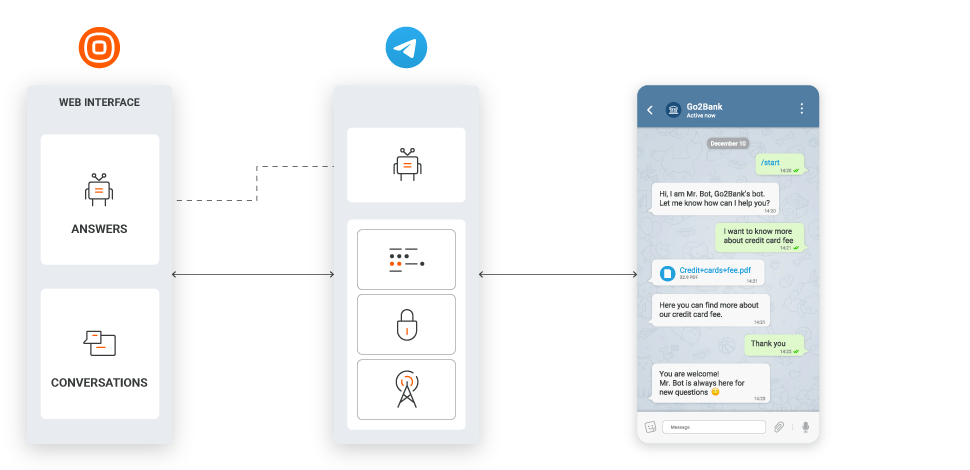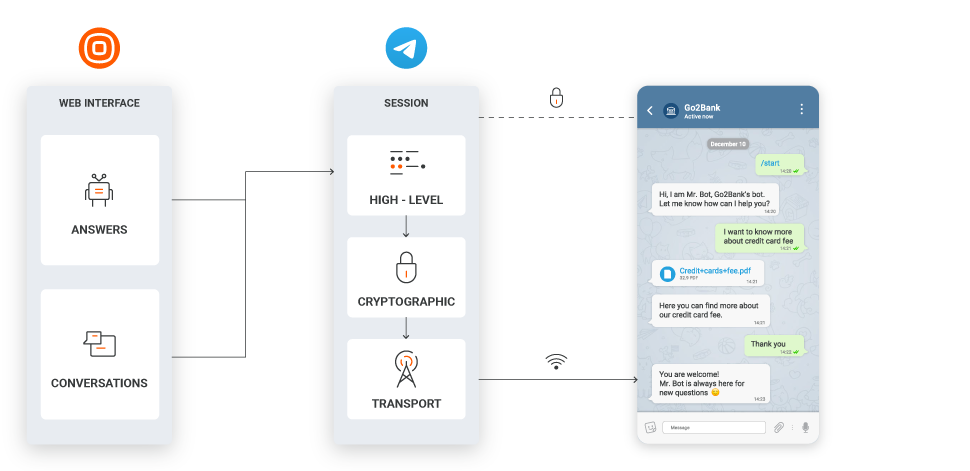Telegram
Telegram is a cloud-based messaging application which can be used over all mobile devices and desktops. It is well known for its strong data security features through message encryption, speed, simplicity, and open APIs. With over 400 million users globally, Telegram is considered to be one of the most popular and powerful messaging applications.
You can read more general information about Telegram in their FAQs (opens in a new tab).

Telegram can be set up to use automated chatbots using Infobip Answersand the Telegram Bots API, and can be used as a direct chat platform using Conversationsif customers need to talk to a human. You can read more about these options in Messaging types.
All messages, commands and requests are processed by Telegram, which handles communication with the Telegram API, and are sent to Infobip. Infobip processes messages in Answers and/or Conversations and sends them back to Telegram over a simplified HTTP interface.
You can read more information in Technical specifications.
Features
Devices
Available to download and use on any device, which supports full synchronization to keep an eye on your account on whichever your desired device, including desktop.
Messages
Use the vast array of messages and content options to exchange with your customers and vice-versa. Including text messages, photos, files, audios, and videos.
Bot integration
Easily integrate Telegram bots with Infobip Answers to create a seamless flow of automated communication all in one platform.
Security
More secure that some other chat apps using encryption, secret chats, self-destruct messages, and forwarding prevention.
Available solutions
Technical specifications
Telegram is an open-source chat app any anyone can check its source code (opens in a new tab), protocol (opens in a new tab), verifiable builds (opens in a new tab) and API (opens in a new tab). It is more secure than some messengers using an array of security features, which you can read more about in Telegram security FAQs (opens in a new tab).

Telegram uses MTProto protocol in order to ensure client-server encryption in Telegram cloud chats. The protocol is designed for access to a server API from applications running on mobile devices. The protocol is subdivided into three virtually independent components:
High-level (API query language): The method whereby API queries and responses are converted to binary messages. The client and the server exchange messages inside a session. The session is attached to the client device rather than a specific Websocket/HTTP/HTTPS/CTP connection. In addition, each session is attached to a user key ID by which authorization is accomplished.
Cryptographic (authorization): The method by which messages are encrypted prior to being transmitted through the transport protocol. Prior to a message being transmitted over a network using a transport protocol, it is encrypted as follows: A user key together with the message key defines an actual 256-bit key which encrypts the message using AES-256 encryption.
Transport: The method for the client and the server to transmit messages over another existing network protocol, such as HTTP, HTTPS, TCP, UDP.
You can read more about protocols at Telegram Protocols (opens in a new tab).